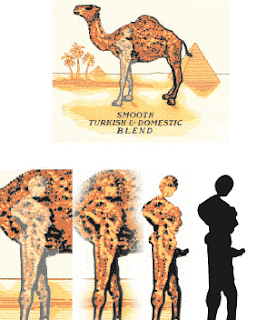
A clear example of the significance of Renaissance paintings to twentieth-century art can be seen in the works below. Frida Kahlo, influenced by the symbolism in Renaissance paintings, refers to the way they express everyday life, like people could look in one work of Hans Holbein portraits.
The first picture is
Portrait of the Merchant Georg Gisze, 1532, Oil and tempera on oak.
Hans Holbein painted this large portrait at the beginning of his second period in England in search of work. From the objects shown in this portrait it is evident that the sitter was anxious that not only his likeness but also something of his way of life should be presented. On the surface, the picture appears super-realistic; but on closer inspection it contains a series of deliberate optical paradoxes. The walls, for example, are not at a right angle, and the table, as shown in the bottom right of the painting, where objects overhang its edge, is not rectangular. Certain objects on the table are not painted flat to the surface, and the vase and the money tin are precariously positioned. The overlapping of the book by the note, or cartellino, fixed to the wall by sealing wax, is an optical illusion given the bulk of the book. The balance hangs unstably from the shelf; and next to it is inscribed Gisze's motto: "Nulla sine merore voluptas" (no pleasure without regret), implying a symbolic connection with the scales.
The merchant is depicted standing in his workroom, behind a table covered with a richly embroidered cloth. Among the many objects on the table and the wall which illustrate his trade, the Venetian-glass vase, containing carnations and other flowers, clearly has a special significance; in the medieval language of symbols the carnation was a sign of betrothal.
In 1939, the Mexican bohemian artist Frida Kahlo completed one of her most telling self-portraits, The Two Fridas (Las Dos Fridas). This painting depicts the traditionally Mexican minded, traditionally Mexican dressed Frida hurt and exposed, sitting next to, and holding the right hand of the strong, independent, cosmopolitan Frida, who is obviously the protector of the weaker, more traditional Frida. The hearts of both Fridas are visible, and the heart of the traditional Frida is cut and torn open. The main artery, which comes from the torn heart down to the right hand of the traditional Frida, is severed. She uses surgical pincers to try to stem the flow of blood, yet it continues to drip down onto her white dress, forming an expanding crimson pool. The heart of the strong Frida, however, is fully intact and is feeding lifeblood through a connecting vein to the weaker, traditional Frida.

Frida Kahlo existed in a society that taught her to desire to be a perfect mother and wife. The circumstances of her life, however, would never allow for that. Each person is affected by a lifetime of individual experiences. What an individual does with those experiences is a true indicator of character. Frida Kahlo is a perfect example of one’s life experiences being used to educate and strengthen an individual. She lived for only 47 hard, painful years, yet she proved herself a woman who would not live according to the social expectations of her time and culture. The strong Frida in Kahlo’s portrait The Two Fridas is the woman she became when she realized that her society's traditions and cultural expectations were unreachable and unrealistic. The traditional Frida in the portrait does not convey any physical disability. Instead, what is laid before the audience is a woman whose traditional clothes are torn and stained, her shattered heart exposed. What is seen is a woman beaten down by the life she was expected to live. The traditional Frida’s saving grace is that the strong Frida recognized these quixotic demands for what they were, and adjusted her life accordingly. What emerged is the Frida Kahlo that feminists have proudly been able to hold up as an icon of strength, leadership, and rugged individualism.
The two works show the lifestyle of the characters at different times and different circumstances. Holbein in his painting shows a typical day in the life of the trader, while Frida Kahlo shows in his way of life and feelings at that time. The two paintings express his life with different symbols, for example, with objects, background, and to position the same character. Finally, the viewer perceives the sensation of being at the time or feel what the artist expresses in his work.
 The realism in his pictures and le had a great influence on the impressionists and, through them, on 20th-century art. Norman Rockwell was a 20th century American painter and illustrator. His works enjoy a broad popular appeal in the United States, where Rockwell is most famous for the cover illustrations of everyday life scenarios.
The realism in his pictures and le had a great influence on the impressionists and, through them, on 20th-century art. Norman Rockwell was a 20th century American painter and illustrator. His works enjoy a broad popular appeal in the United States, where Rockwell is most famous for the cover illustrations of everyday life scenarios.



 Cezanne was obsessed with form rather than content, so the subject was not important to him, also he paved the way for modern art by directly influencing Cubists. This artist used an impasto technique-thick, emotional strokes stabbing at the canvas with his palette knife. Artists use this technique today.
Cezanne was obsessed with form rather than content, so the subject was not important to him, also he paved the way for modern art by directly influencing Cubists. This artist used an impasto technique-thick, emotional strokes stabbing at the canvas with his palette knife. Artists use this technique today.







 As well as Turner, who based his pictures in natural disasters, and landscapes of destruction and sadness in the world. Both, they used colours to emphasize the dramatic scene, the predominant basic colors and solid, and the use of reflexes. Turner's first period is marked by mythological and historical scenes in which the coloring is subdued and details and contours are emphasized. Both, also used monuments socially representatives for its emotional value. Currently, Roland uses computer images and animations, applying realistic effects such as reflections in water and wind action on objects, as Turner did in his painting “The Burning of the Houses of Parliament”, which clearly note the direction of wind and fire intensity. These techniques give a realistic effect that impacts the viewer through their feelings of sadness, fear and helplessness.
As well as Turner, who based his pictures in natural disasters, and landscapes of destruction and sadness in the world. Both, they used colours to emphasize the dramatic scene, the predominant basic colors and solid, and the use of reflexes. Turner's first period is marked by mythological and historical scenes in which the coloring is subdued and details and contours are emphasized. Both, also used monuments socially representatives for its emotional value. Currently, Roland uses computer images and animations, applying realistic effects such as reflections in water and wind action on objects, as Turner did in his painting “The Burning of the Houses of Parliament”, which clearly note the direction of wind and fire intensity. These techniques give a realistic effect that impacts the viewer through their feelings of sadness, fear and helplessness.

















